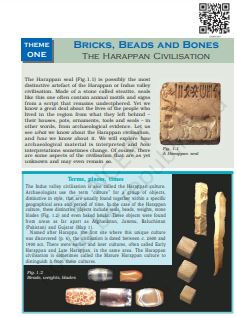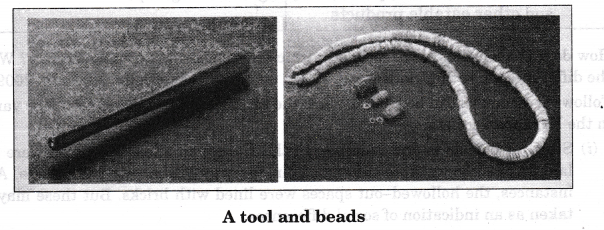‘Bricks Beads And Bones NCERT Solutions for Class 12 History Chapter 1′ PDF Quick download link is given at the bottom of this article. You can see the PDF demo, size of the PDF, page numbers, and direct download Free PDF of ‘The Harappan Civilisation Ncert Class 12 History Chapter 1 Exercise Solution’ using the download button.
Bricks Beads And Bones (The Harappan Civilisation) NCERT Textbook With Solutions PDF Free Download

Chapter 1: Bricks Beads And Bones The Harappan Civilisation
There were several archaeological cultures in the region prior to the Mature Harappan.
These cultures were associated with distinctive pottery, evidence of agriculture and pastoralism, and some crafts.
Settlements were generally small, and there were virtually no large buildings.
It appears that there was a break between the Early Harappan and the Harappan civilization, evident from large-scale burning at some sites, as well as the abandonment of certain settlements.
If you look at Maps 1 and 2 you will notice that the Mature Harappan culture developed in some of the areas occupied by the Early Harappan cultures. These cultures also shared certain common elements including subsistence strategies.
The Harappans ate a wide range of plant and animal products, including fish.
Archaeologists have been able to reconstruct dietary practices from finds of charred grains and seeds. These are studied by archaeo-botanists, who are specialists in ancient plant remains.
Animal bones found at Harappan sites include those of cattle, sheep, goats, buffalo, and pigs.
Studies done by archaeo-zoologists or zooarchaeologists indicate that these animals were domesticated.
Bones of wild species such as boar, deer, and gharial are also found. We do not know whether the Harappans hunted these animals themselves or obtained meat from other hunting
communities. Bones of fish and fowl are also found.
While the prevalence of agriculture is indicated by finds of grain, it is more difficult to reconstruct actual agricultural practices. Were seeds broadcast (scattered) on plowed lands?
Representations on seals and terracotta sculptures indicate that the bull was known, and archaeologists extrapolate from this that oxen were used for plowing.
Moreover, terracotta models of the plow have been found at sites in the Cholistan and at Banawali (Haryana).
Archaeologists have also found evidence of a plowed field at Kalibangan (Rajasthan),
associated with Early Harappan levels (see p. 20). The field had two sets of furrows at right angles to each other, suggesting that two different crops were grown together.
Archaeologists have also tried to identify the tools used for harvesting. Did the Harappans use
stone blades set in wooden handles or did they use metal tools?
Most Harappan sites are located in semi-arid lands, where irrigation was probably required for
agriculture.
Traces of canals have been found at the Harappan site of Shortughai in Afghanistan, but not in Punjab or Sind. It is possible that ancient
canals silted up long ago. It is also likely that water drawn from wells was used for irrigation. Besides, water reservoirs found in Dholavira (Gujarat) may have been used to store water for agriculture.
Perhaps the most unique feature of the Harappan civilization was the development of urban centers.
Let us look at one such center, Mohenjodaro, more closely. Although Mohenjodaro is the most well-known site, the first site to be discovered was Harappa.
The Lower Town was also walled. Several buildings were built on platforms, which served as foundations.
It has been calculated that if one laborer moved roughly a cubic meter of earth daily, just to put the foundations in place it would have required four a million person-days, in other words, mobilizing labor on a very large scale.
| Author | NCERT |
| Language | English |
| No. of Pages | 27 |
| PDF Size | 5.2 MB |
| Category | History |
| Source/Credits | ncert.nic.in |
NCERT Solutions Class 12 History Chapter 1 The Harappan Civilisation
1. List the items of food available to people in Harappan cities. Identify the groups who would have provided these.
Ans:
2. How do archaeologists trace socio-economic differences in Harappan society? What are the differences that they notice? [Delhi, All India 2009, 2011]
Ans: (a) Archaeologists trace socio-economic differences in Harappan society in the following ways:
- Burials
- Looking for “luxuries”.
(b) The archaeologists have noticed the following differences in the socio-economic conditions in Harappan society :
- In the Harappan society, the dead were generally laid in pits. In some burial pits, the hollowed-out spaces were lined with bricks.
- Some graves contain pottery and ornaments.
- In some instances, the dead were buried with copper mirrors.
- Artifacts are divided into two categories – utilitarian and luxuries. The utilitarian objects are of daily use. These are made of ordinary materials such as stone and clay.
- These are found in all settlements. Luxury items are found in the large settlements of Harappa and Mohenjodaro. These are made of valuable materials like faience. Gold too was rare and precious as all the gold jewelry has been found at Harappan sites.
3. Would you agree that the drainage system in Harappan cities indicates town planning? Give reasons for your answer.
Ans: Yes, I agree that the drainage system in Harappan cities which indicates the town planning. I can cite the following reasons in support of my answer.
- The drainage system needed planning for its execution. It seems that first drainages were laid out and then houses were built along with the drains.
- Every house was supposed to have at least one wall along a street to allow the domestic wastewater to flow out in the street drains.
- The plans of the lower town show that roads and streets were laid out along an approximate grid pattern, intersecting at right angles.
- It appears that human settlement was made by planning from the beginning. The city was restricted to a fixed area on the platforms.
- Bricks, sundried or baked, were of standard ratio. The length and breadth of bricks were of four times and twice the height respectively These bricks were used at all the settlements of the Harappan Civilisation.
4. List the materials used to make beads in the Harappan Civilisation. Describe the process by which any one kind of bead was made.
Ans: Making beads was an important craft of the Harappan people. It was mainly prevalent in Chanhudaro.
Materials for making beads included beautiful red-colored stone-like carnelian, jasper, crystal, quartz, and steatite. Besides these, the use of copper, bronze, gold, shell, faience, terracotta, or burnt clay was also used. Process of making beads Making of beads differed as per the materials used. Beads had a variety of shapes. They did not make geometrical shapes like one made of harder stones.
Nodules were to be chipped for making rough shapes. They were finally flaked into the final form.
By firing the yellowish raw material, the red color of camelina was obtained. Grinding, polishing, and drilling constituted the last phase. Chanhudaro, Lothal, and Dholavira were famous for specialized drilling.
5. Look at figure 1.30 (See NCERT page-26) and describe what you see. How is the body placed? What are the objects placed near it? Are there any artifacts on the body? Do these indicate the sex of the skeleton?
Ans: Following observations can be obtained after looking at the figure:
- The body has been kept in a North-south direction in a pit,
- Many graves contain pottery and ornaments which include jars.
- Yes, jewelry like bangles is there on the body.
- Yes, this indicates the sex of the skeleton, Le. it is the body of a woman.
It is concluded that there were great social or economic differences among the people living within the area of the Harappan Civilisation. But as a whole, it appears that the Harappan did not believe in burying precious things with the dead.
PDFs Related To The Harappan Civilisation
- Kings Farmers And Towns PDF
- Kinship Caste and Class PDF
- Thinkers Beliefs Buildings PDF
- Bhakti And Sufi Traditions PDF
The Harappan Civilisation NCERT Class 12 History Textbook Chapter 1 With Answer PDF Free Download
